Economics Evaluation: Anxiety Intervention in Secondary Students
VerifiedAdded on 2023/03/17
|12
|2601
|46
Report
AI Summary
This report presents an economics evaluation of an anxiety intervention designed to address anxiety among secondary school students. The study evaluates the most effective and resource-efficient intervention, comparing online modules with randomized controlled trials (RCTs). The report outlines the target population, intervention components, and expected health outcomes, including measures of referrals and anxiety diagnosis. The study utilizes a cost-benefit analysis, considering perspectives of health providers, families, and students. It identifies and categorizes the resources needed, including health care and non-health care costs, patient costs, and productivity loss. The report also discusses data sources and valuation of resource inputs, focusing on measuring health outcomes through methods such as improved mental stability and the "life chart" theory. The conclusion emphasizes the prevalence of anxiety and the importance of the intervention for secondary school students. The report includes references to relevant studies and resources.
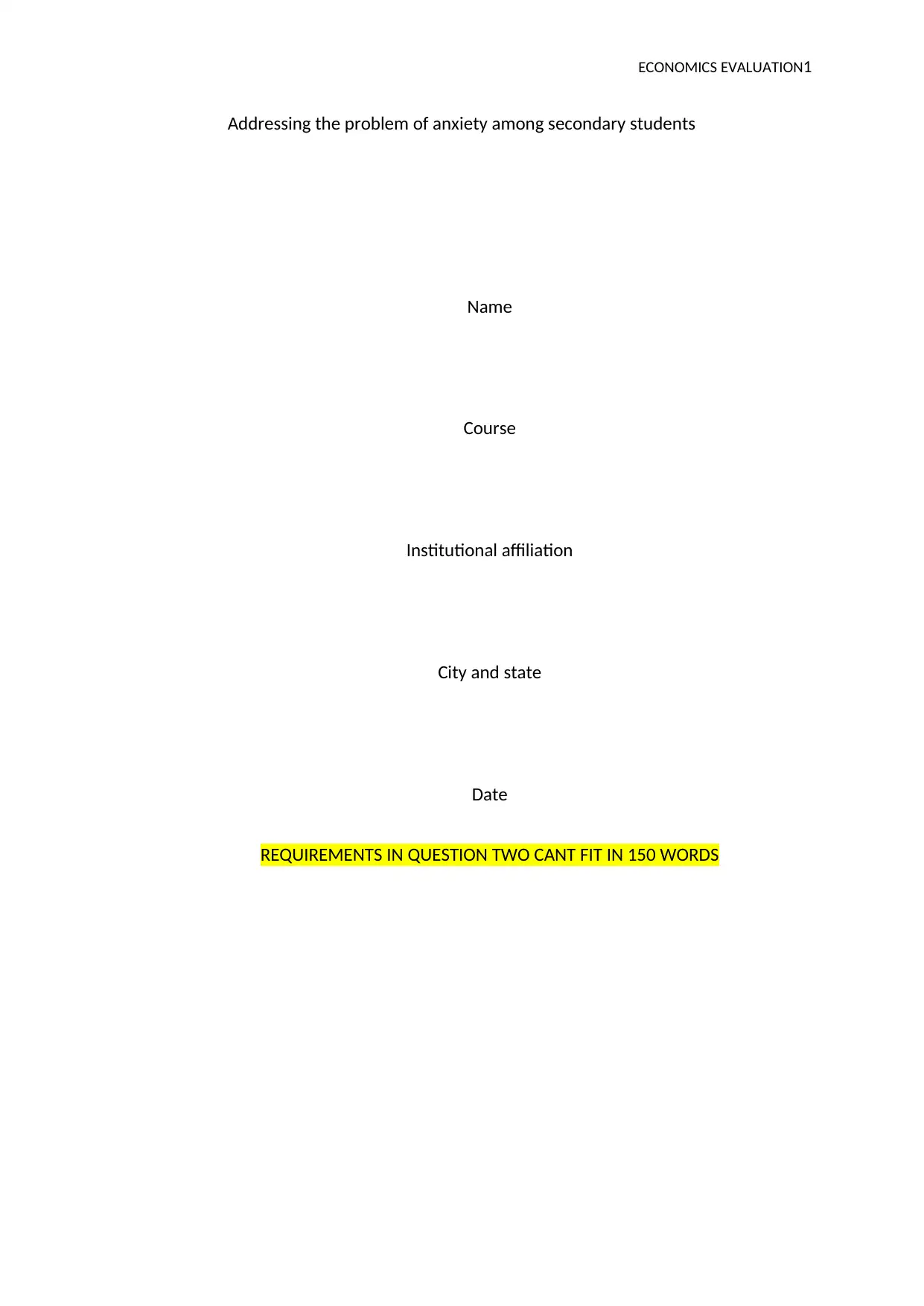
ECONOMICS EVALUATION1
Addressing the problem of anxiety among secondary students
Name
Course
Institutional affiliation
City and state
Date
REQUIREMENTS IN QUESTION TWO CANT FIT IN 150 WORDS
Addressing the problem of anxiety among secondary students
Name
Course
Institutional affiliation
City and state
Date
REQUIREMENTS IN QUESTION TWO CANT FIT IN 150 WORDS
Paraphrase This Document
Need a fresh take? Get an instant paraphrase of this document with our AI Paraphraser
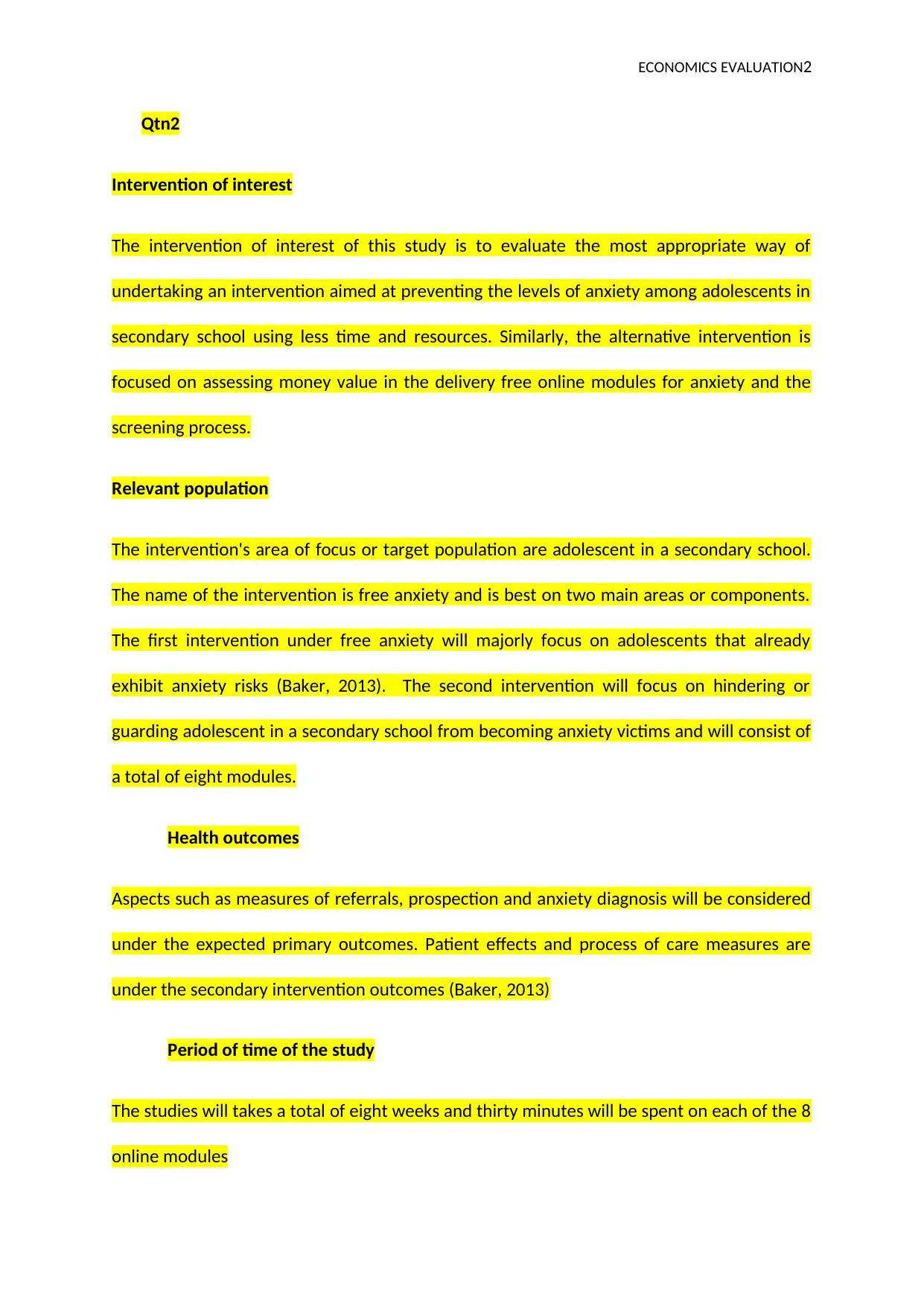
ECONOMICS EVALUATION2
Qtn2
Intervention of interest
The intervention of interest of this study is to evaluate the most appropriate way of
undertaking an intervention aimed at preventing the levels of anxiety among adolescents in
secondary school using less time and resources. Similarly, the alternative intervention is
focused on assessing money value in the delivery free online modules for anxiety and the
screening process.
Relevant population
The intervention's area of focus or target population are adolescent in a secondary school.
The name of the intervention is free anxiety and is best on two main areas or components.
The first intervention under free anxiety will majorly focus on adolescents that already
exhibit anxiety risks (Baker, 2013). The second intervention will focus on hindering or
guarding adolescent in a secondary school from becoming anxiety victims and will consist of
a total of eight modules.
Health outcomes
Aspects such as measures of referrals, prospection and anxiety diagnosis will be considered
under the expected primary outcomes. Patient effects and process of care measures are
under the secondary intervention outcomes (Baker, 2013)
Period of time of the study
The studies will takes a total of eight weeks and thirty minutes will be spent on each of the 8
online modules
Qtn2
Intervention of interest
The intervention of interest of this study is to evaluate the most appropriate way of
undertaking an intervention aimed at preventing the levels of anxiety among adolescents in
secondary school using less time and resources. Similarly, the alternative intervention is
focused on assessing money value in the delivery free online modules for anxiety and the
screening process.
Relevant population
The intervention's area of focus or target population are adolescent in a secondary school.
The name of the intervention is free anxiety and is best on two main areas or components.
The first intervention under free anxiety will majorly focus on adolescents that already
exhibit anxiety risks (Baker, 2013). The second intervention will focus on hindering or
guarding adolescent in a secondary school from becoming anxiety victims and will consist of
a total of eight modules.
Health outcomes
Aspects such as measures of referrals, prospection and anxiety diagnosis will be considered
under the expected primary outcomes. Patient effects and process of care measures are
under the secondary intervention outcomes (Baker, 2013)
Period of time of the study
The studies will takes a total of eight weeks and thirty minutes will be spent on each of the 8
online modules
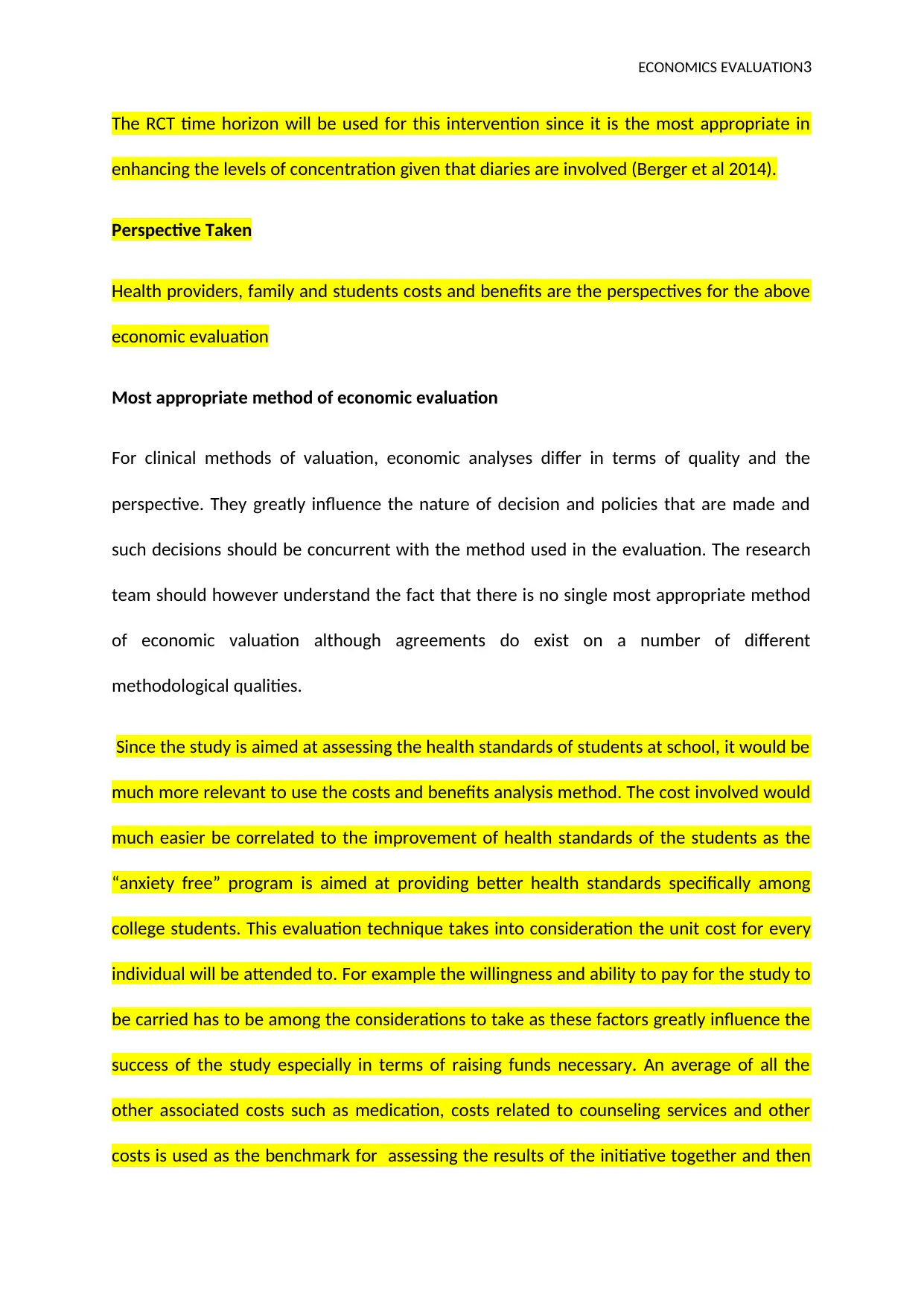
ECONOMICS EVALUATION3
The RCT time horizon will be used for this intervention since it is the most appropriate in
enhancing the levels of concentration given that diaries are involved (Berger et al 2014).
Perspective Taken
Health providers, family and students costs and benefits are the perspectives for the above
economic evaluation
Most appropriate method of economic evaluation
For clinical methods of valuation, economic analyses differ in terms of quality and the
perspective. They greatly influence the nature of decision and policies that are made and
such decisions should be concurrent with the method used in the evaluation. The research
team should however understand the fact that there is no single most appropriate method
of economic valuation although agreements do exist on a number of different
methodological qualities.
Since the study is aimed at assessing the health standards of students at school, it would be
much more relevant to use the costs and benefits analysis method. The cost involved would
much easier be correlated to the improvement of health standards of the students as the
“anxiety free” program is aimed at providing better health standards specifically among
college students. This evaluation technique takes into consideration the unit cost for every
individual will be attended to. For example the willingness and ability to pay for the study to
be carried has to be among the considerations to take as these factors greatly influence the
success of the study especially in terms of raising funds necessary. An average of all the
other associated costs such as medication, costs related to counseling services and other
costs is used as the benchmark for assessing the results of the initiative together and then
The RCT time horizon will be used for this intervention since it is the most appropriate in
enhancing the levels of concentration given that diaries are involved (Berger et al 2014).
Perspective Taken
Health providers, family and students costs and benefits are the perspectives for the above
economic evaluation
Most appropriate method of economic evaluation
For clinical methods of valuation, economic analyses differ in terms of quality and the
perspective. They greatly influence the nature of decision and policies that are made and
such decisions should be concurrent with the method used in the evaluation. The research
team should however understand the fact that there is no single most appropriate method
of economic valuation although agreements do exist on a number of different
methodological qualities.
Since the study is aimed at assessing the health standards of students at school, it would be
much more relevant to use the costs and benefits analysis method. The cost involved would
much easier be correlated to the improvement of health standards of the students as the
“anxiety free” program is aimed at providing better health standards specifically among
college students. This evaluation technique takes into consideration the unit cost for every
individual will be attended to. For example the willingness and ability to pay for the study to
be carried has to be among the considerations to take as these factors greatly influence the
success of the study especially in terms of raising funds necessary. An average of all the
other associated costs such as medication, costs related to counseling services and other
costs is used as the benchmark for assessing the results of the initiative together and then
⊘ This is a preview!⊘
Do you want full access?
Subscribe today to unlock all pages.

Trusted by 1+ million students worldwide
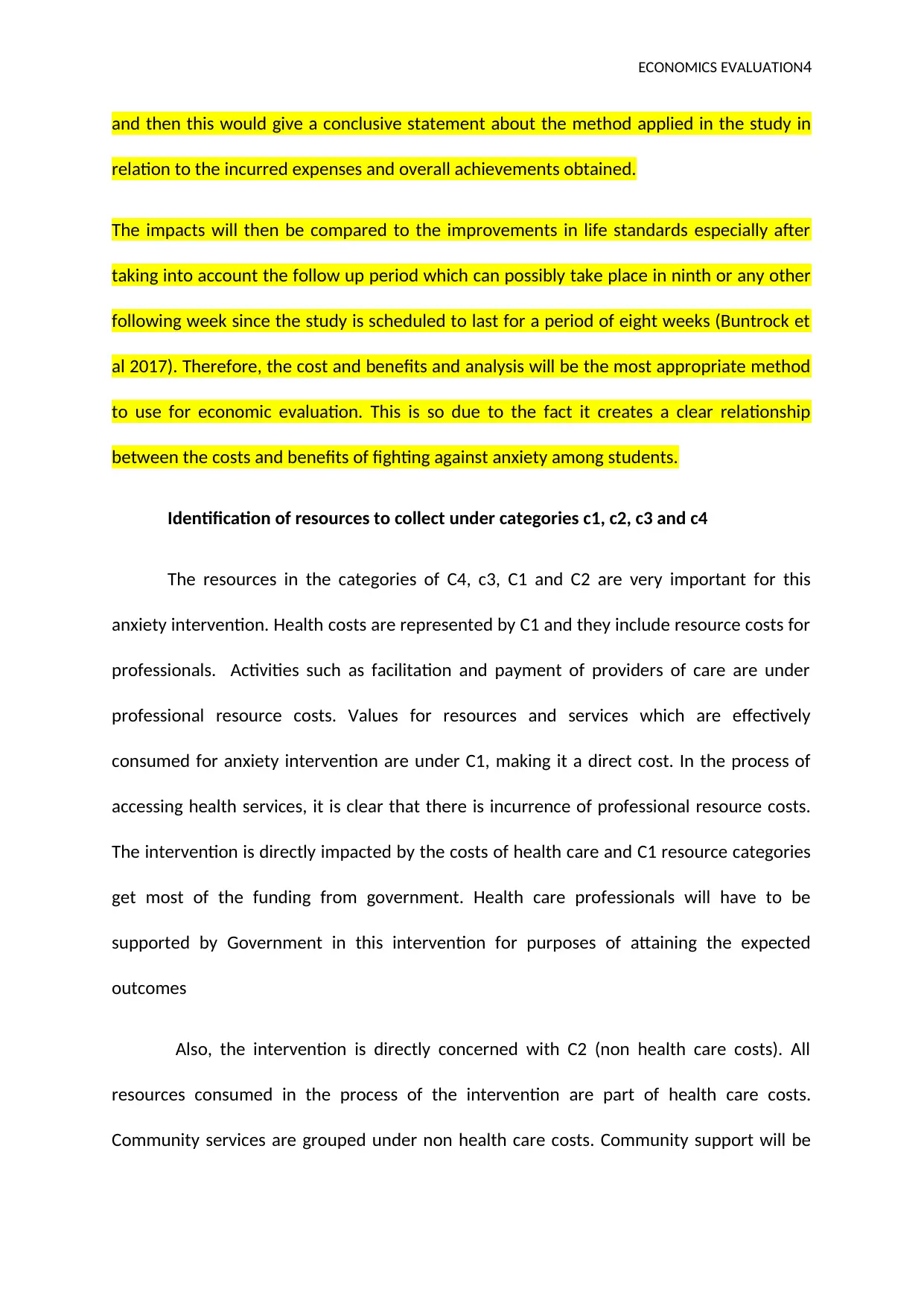
ECONOMICS EVALUATION4
and then this would give a conclusive statement about the method applied in the study in
relation to the incurred expenses and overall achievements obtained.
The impacts will then be compared to the improvements in life standards especially after
taking into account the follow up period which can possibly take place in ninth or any other
following week since the study is scheduled to last for a period of eight weeks (Buntrock et
al 2017). Therefore, the cost and benefits and analysis will be the most appropriate method
to use for economic evaluation. This is so due to the fact it creates a clear relationship
between the costs and benefits of fighting against anxiety among students.
Identification of resources to collect under categories c1, c2, c3 and c4
The resources in the categories of C4, c3, C1 and C2 are very important for this
anxiety intervention. Health costs are represented by C1 and they include resource costs for
professionals. Activities such as facilitation and payment of providers of care are under
professional resource costs. Values for resources and services which are effectively
consumed for anxiety intervention are under C1, making it a direct cost. In the process of
accessing health services, it is clear that there is incurrence of professional resource costs.
The intervention is directly impacted by the costs of health care and C1 resource categories
get most of the funding from government. Health care professionals will have to be
supported by Government in this intervention for purposes of attaining the expected
outcomes
Also, the intervention is directly concerned with C2 (non health care costs). All
resources consumed in the process of the intervention are part of health care costs.
Community services are grouped under non health care costs. Community support will be
and then this would give a conclusive statement about the method applied in the study in
relation to the incurred expenses and overall achievements obtained.
The impacts will then be compared to the improvements in life standards especially after
taking into account the follow up period which can possibly take place in ninth or any other
following week since the study is scheduled to last for a period of eight weeks (Buntrock et
al 2017). Therefore, the cost and benefits and analysis will be the most appropriate method
to use for economic evaluation. This is so due to the fact it creates a clear relationship
between the costs and benefits of fighting against anxiety among students.
Identification of resources to collect under categories c1, c2, c3 and c4
The resources in the categories of C4, c3, C1 and C2 are very important for this
anxiety intervention. Health costs are represented by C1 and they include resource costs for
professionals. Activities such as facilitation and payment of providers of care are under
professional resource costs. Values for resources and services which are effectively
consumed for anxiety intervention are under C1, making it a direct cost. In the process of
accessing health services, it is clear that there is incurrence of professional resource costs.
The intervention is directly impacted by the costs of health care and C1 resource categories
get most of the funding from government. Health care professionals will have to be
supported by Government in this intervention for purposes of attaining the expected
outcomes
Also, the intervention is directly concerned with C2 (non health care costs). All
resources consumed in the process of the intervention are part of health care costs.
Community services are grouped under non health care costs. Community support will be
Paraphrase This Document
Need a fresh take? Get an instant paraphrase of this document with our AI Paraphraser
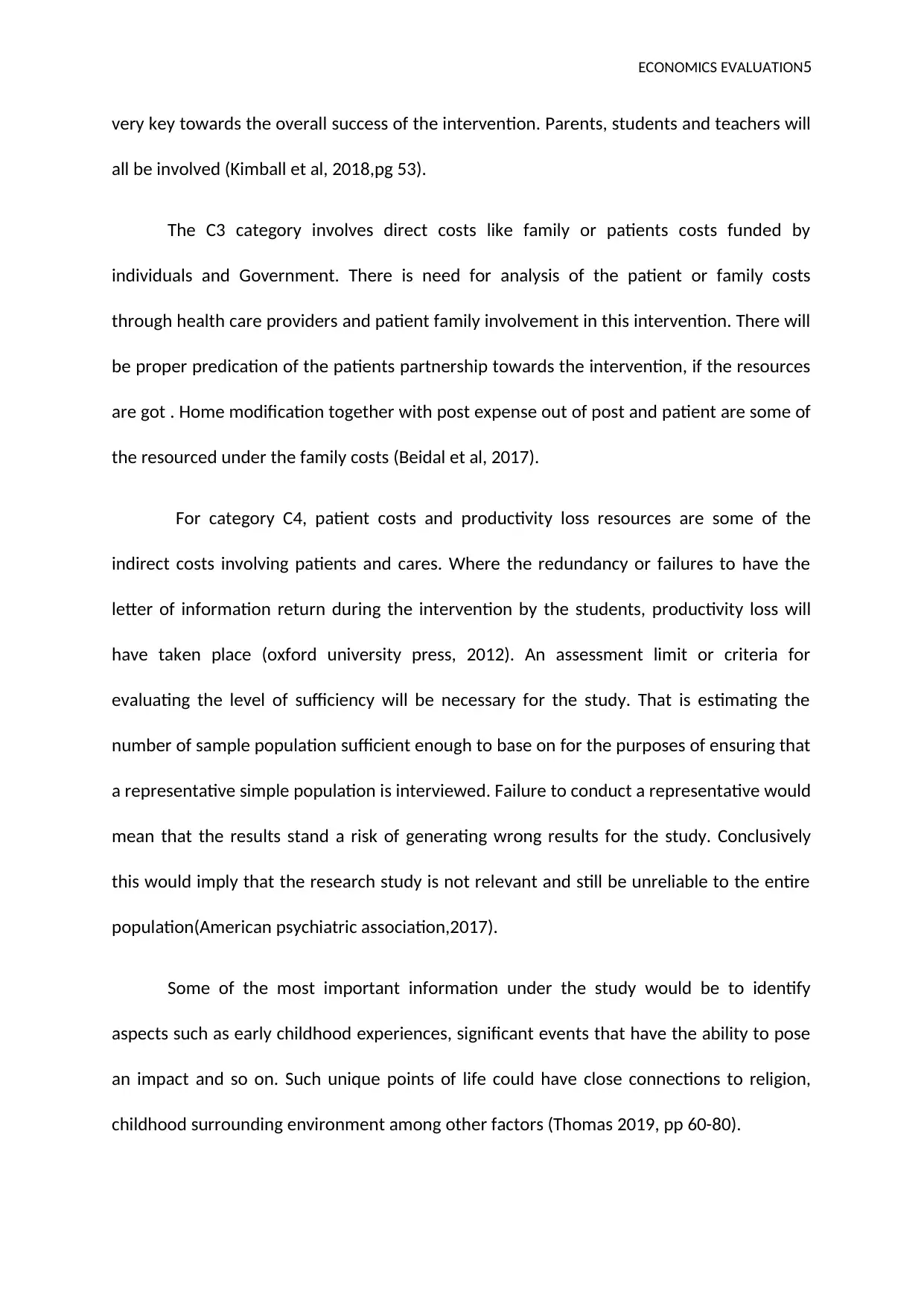
ECONOMICS EVALUATION5
very key towards the overall success of the intervention. Parents, students and teachers will
all be involved (Kimball et al, 2018,pg 53).
The C3 category involves direct costs like family or patients costs funded by
individuals and Government. There is need for analysis of the patient or family costs
through health care providers and patient family involvement in this intervention. There will
be proper predication of the patients partnership towards the intervention, if the resources
are got . Home modification together with post expense out of post and patient are some of
the resourced under the family costs (Beidal et al, 2017).
For category C4, patient costs and productivity loss resources are some of the
indirect costs involving patients and cares. Where the redundancy or failures to have the
letter of information return during the intervention by the students, productivity loss will
have taken place (oxford university press, 2012). An assessment limit or criteria for
evaluating the level of sufficiency will be necessary for the study. That is estimating the
number of sample population sufficient enough to base on for the purposes of ensuring that
a representative simple population is interviewed. Failure to conduct a representative would
mean that the results stand a risk of generating wrong results for the study. Conclusively
this would imply that the research study is not relevant and still be unreliable to the entire
population(American psychiatric association,2017).
Some of the most important information under the study would be to identify
aspects such as early childhood experiences, significant events that have the ability to pose
an impact and so on. Such unique points of life could have close connections to religion,
childhood surrounding environment among other factors (Thomas 2019, pp 60-80).
very key towards the overall success of the intervention. Parents, students and teachers will
all be involved (Kimball et al, 2018,pg 53).
The C3 category involves direct costs like family or patients costs funded by
individuals and Government. There is need for analysis of the patient or family costs
through health care providers and patient family involvement in this intervention. There will
be proper predication of the patients partnership towards the intervention, if the resources
are got . Home modification together with post expense out of post and patient are some of
the resourced under the family costs (Beidal et al, 2017).
For category C4, patient costs and productivity loss resources are some of the
indirect costs involving patients and cares. Where the redundancy or failures to have the
letter of information return during the intervention by the students, productivity loss will
have taken place (oxford university press, 2012). An assessment limit or criteria for
evaluating the level of sufficiency will be necessary for the study. That is estimating the
number of sample population sufficient enough to base on for the purposes of ensuring that
a representative simple population is interviewed. Failure to conduct a representative would
mean that the results stand a risk of generating wrong results for the study. Conclusively
this would imply that the research study is not relevant and still be unreliable to the entire
population(American psychiatric association,2017).
Some of the most important information under the study would be to identify
aspects such as early childhood experiences, significant events that have the ability to pose
an impact and so on. Such unique points of life could have close connections to religion,
childhood surrounding environment among other factors (Thomas 2019, pp 60-80).
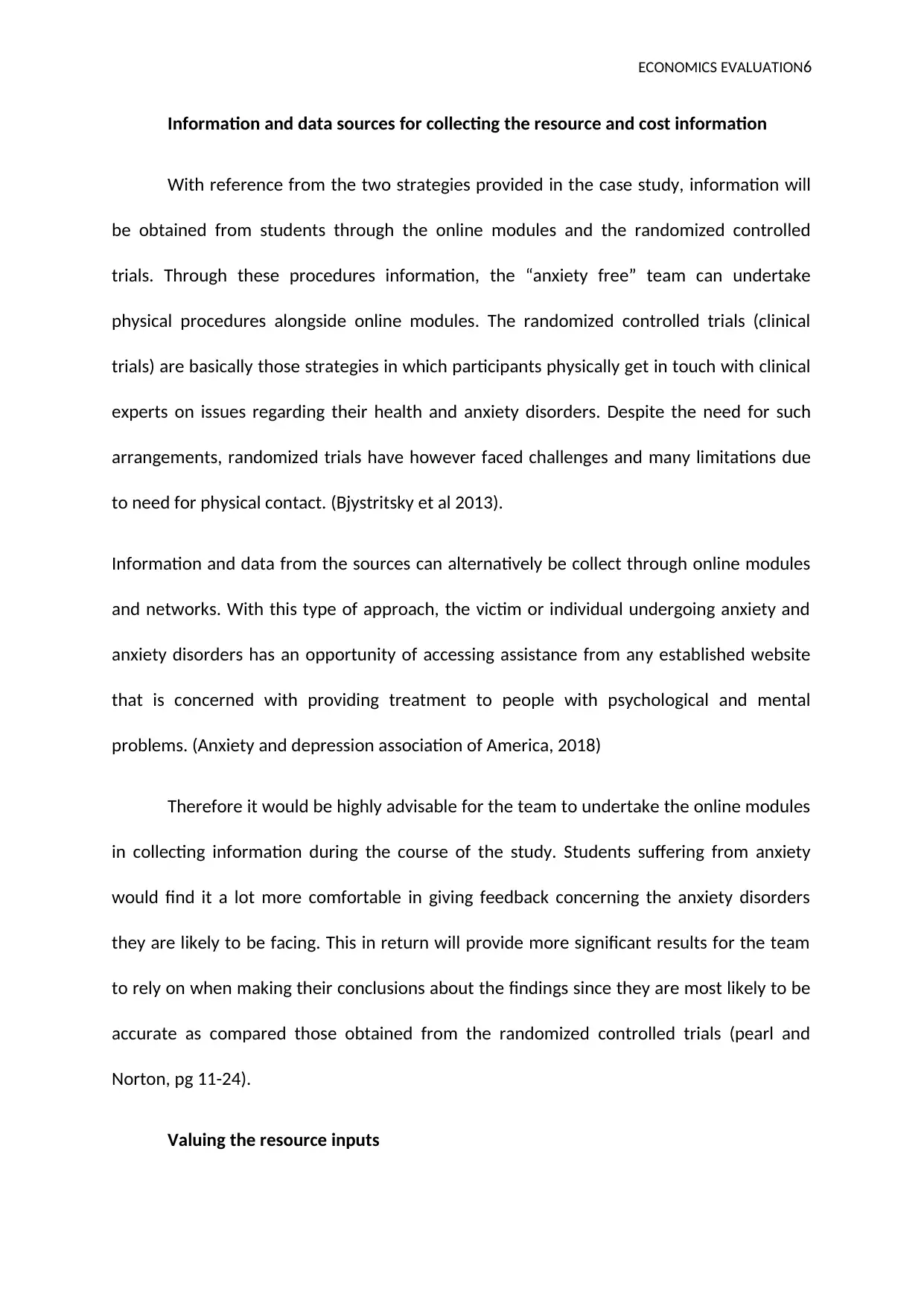
ECONOMICS EVALUATION6
Information and data sources for collecting the resource and cost information
With reference from the two strategies provided in the case study, information will
be obtained from students through the online modules and the randomized controlled
trials. Through these procedures information, the “anxiety free” team can undertake
physical procedures alongside online modules. The randomized controlled trials (clinical
trials) are basically those strategies in which participants physically get in touch with clinical
experts on issues regarding their health and anxiety disorders. Despite the need for such
arrangements, randomized trials have however faced challenges and many limitations due
to need for physical contact. (Bjystritsky et al 2013).
Information and data from the sources can alternatively be collect through online modules
and networks. With this type of approach, the victim or individual undergoing anxiety and
anxiety disorders has an opportunity of accessing assistance from any established website
that is concerned with providing treatment to people with psychological and mental
problems. (Anxiety and depression association of America, 2018)
Therefore it would be highly advisable for the team to undertake the online modules
in collecting information during the course of the study. Students suffering from anxiety
would find it a lot more comfortable in giving feedback concerning the anxiety disorders
they are likely to be facing. This in return will provide more significant results for the team
to rely on when making their conclusions about the findings since they are most likely to be
accurate as compared those obtained from the randomized controlled trials (pearl and
Norton, pg 11-24).
Valuing the resource inputs
Information and data sources for collecting the resource and cost information
With reference from the two strategies provided in the case study, information will
be obtained from students through the online modules and the randomized controlled
trials. Through these procedures information, the “anxiety free” team can undertake
physical procedures alongside online modules. The randomized controlled trials (clinical
trials) are basically those strategies in which participants physically get in touch with clinical
experts on issues regarding their health and anxiety disorders. Despite the need for such
arrangements, randomized trials have however faced challenges and many limitations due
to need for physical contact. (Bjystritsky et al 2013).
Information and data from the sources can alternatively be collect through online modules
and networks. With this type of approach, the victim or individual undergoing anxiety and
anxiety disorders has an opportunity of accessing assistance from any established website
that is concerned with providing treatment to people with psychological and mental
problems. (Anxiety and depression association of America, 2018)
Therefore it would be highly advisable for the team to undertake the online modules
in collecting information during the course of the study. Students suffering from anxiety
would find it a lot more comfortable in giving feedback concerning the anxiety disorders
they are likely to be facing. This in return will provide more significant results for the team
to rely on when making their conclusions about the findings since they are most likely to be
accurate as compared those obtained from the randomized controlled trials (pearl and
Norton, pg 11-24).
Valuing the resource inputs
⊘ This is a preview!⊘
Do you want full access?
Subscribe today to unlock all pages.

Trusted by 1+ million students worldwide
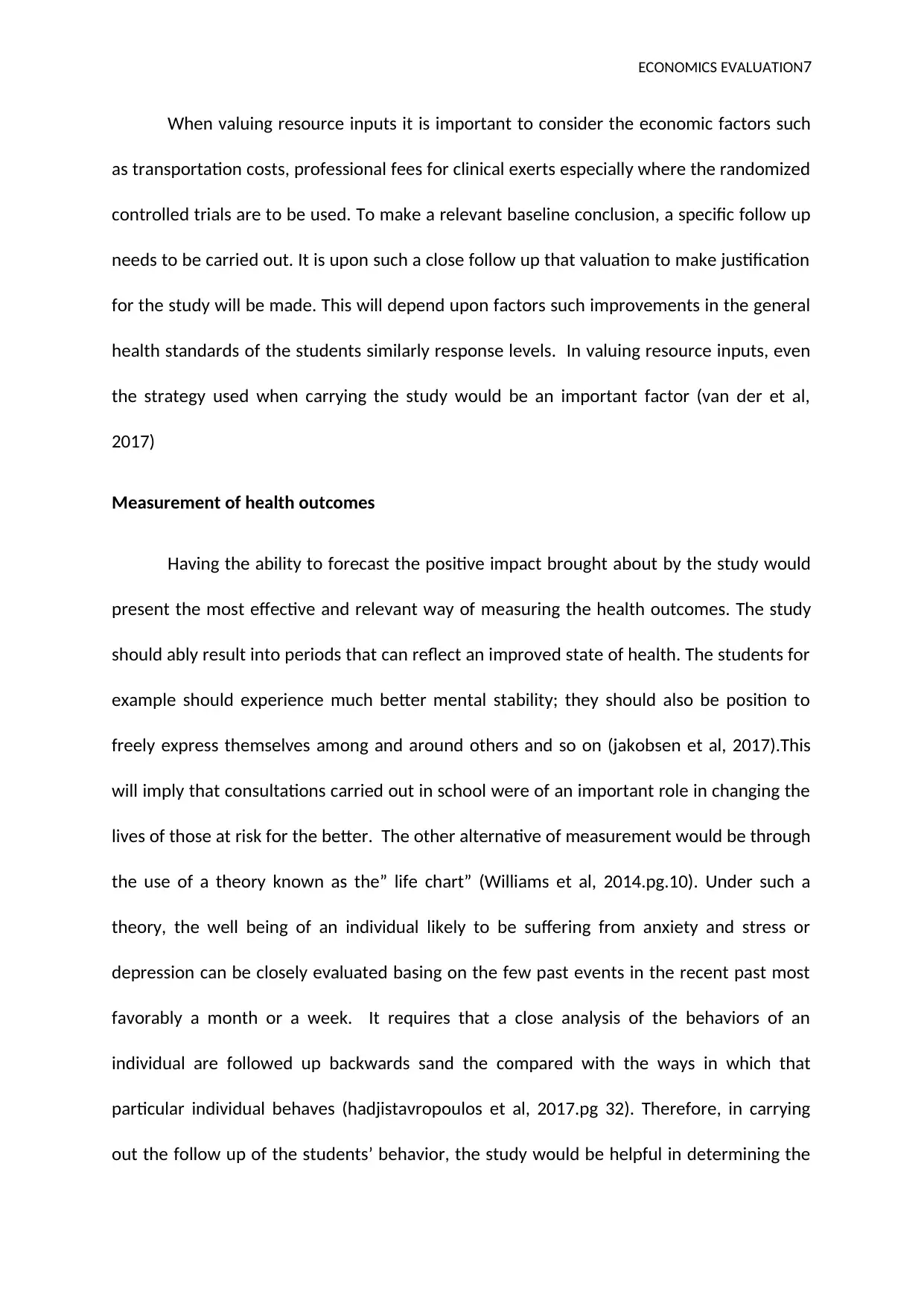
ECONOMICS EVALUATION7
When valuing resource inputs it is important to consider the economic factors such
as transportation costs, professional fees for clinical exerts especially where the randomized
controlled trials are to be used. To make a relevant baseline conclusion, a specific follow up
needs to be carried out. It is upon such a close follow up that valuation to make justification
for the study will be made. This will depend upon factors such improvements in the general
health standards of the students similarly response levels. In valuing resource inputs, even
the strategy used when carrying the study would be an important factor (van der et al,
2017)
Measurement of health outcomes
Having the ability to forecast the positive impact brought about by the study would
present the most effective and relevant way of measuring the health outcomes. The study
should ably result into periods that can reflect an improved state of health. The students for
example should experience much better mental stability; they should also be position to
freely express themselves among and around others and so on (jakobsen et al, 2017).This
will imply that consultations carried out in school were of an important role in changing the
lives of those at risk for the better. The other alternative of measurement would be through
the use of a theory known as the” life chart” (Williams et al, 2014.pg.10). Under such a
theory, the well being of an individual likely to be suffering from anxiety and stress or
depression can be closely evaluated basing on the few past events in the recent past most
favorably a month or a week. It requires that a close analysis of the behaviors of an
individual are followed up backwards sand the compared with the ways in which that
particular individual behaves (hadjistavropoulos et al, 2017.pg 32). Therefore, in carrying
out the follow up of the students’ behavior, the study would be helpful in determining the
When valuing resource inputs it is important to consider the economic factors such
as transportation costs, professional fees for clinical exerts especially where the randomized
controlled trials are to be used. To make a relevant baseline conclusion, a specific follow up
needs to be carried out. It is upon such a close follow up that valuation to make justification
for the study will be made. This will depend upon factors such improvements in the general
health standards of the students similarly response levels. In valuing resource inputs, even
the strategy used when carrying the study would be an important factor (van der et al,
2017)
Measurement of health outcomes
Having the ability to forecast the positive impact brought about by the study would
present the most effective and relevant way of measuring the health outcomes. The study
should ably result into periods that can reflect an improved state of health. The students for
example should experience much better mental stability; they should also be position to
freely express themselves among and around others and so on (jakobsen et al, 2017).This
will imply that consultations carried out in school were of an important role in changing the
lives of those at risk for the better. The other alternative of measurement would be through
the use of a theory known as the” life chart” (Williams et al, 2014.pg.10). Under such a
theory, the well being of an individual likely to be suffering from anxiety and stress or
depression can be closely evaluated basing on the few past events in the recent past most
favorably a month or a week. It requires that a close analysis of the behaviors of an
individual are followed up backwards sand the compared with the ways in which that
particular individual behaves (hadjistavropoulos et al, 2017.pg 32). Therefore, in carrying
out the follow up of the students’ behavior, the study would be helpful in determining the
Paraphrase This Document
Need a fresh take? Get an instant paraphrase of this document with our AI Paraphraser
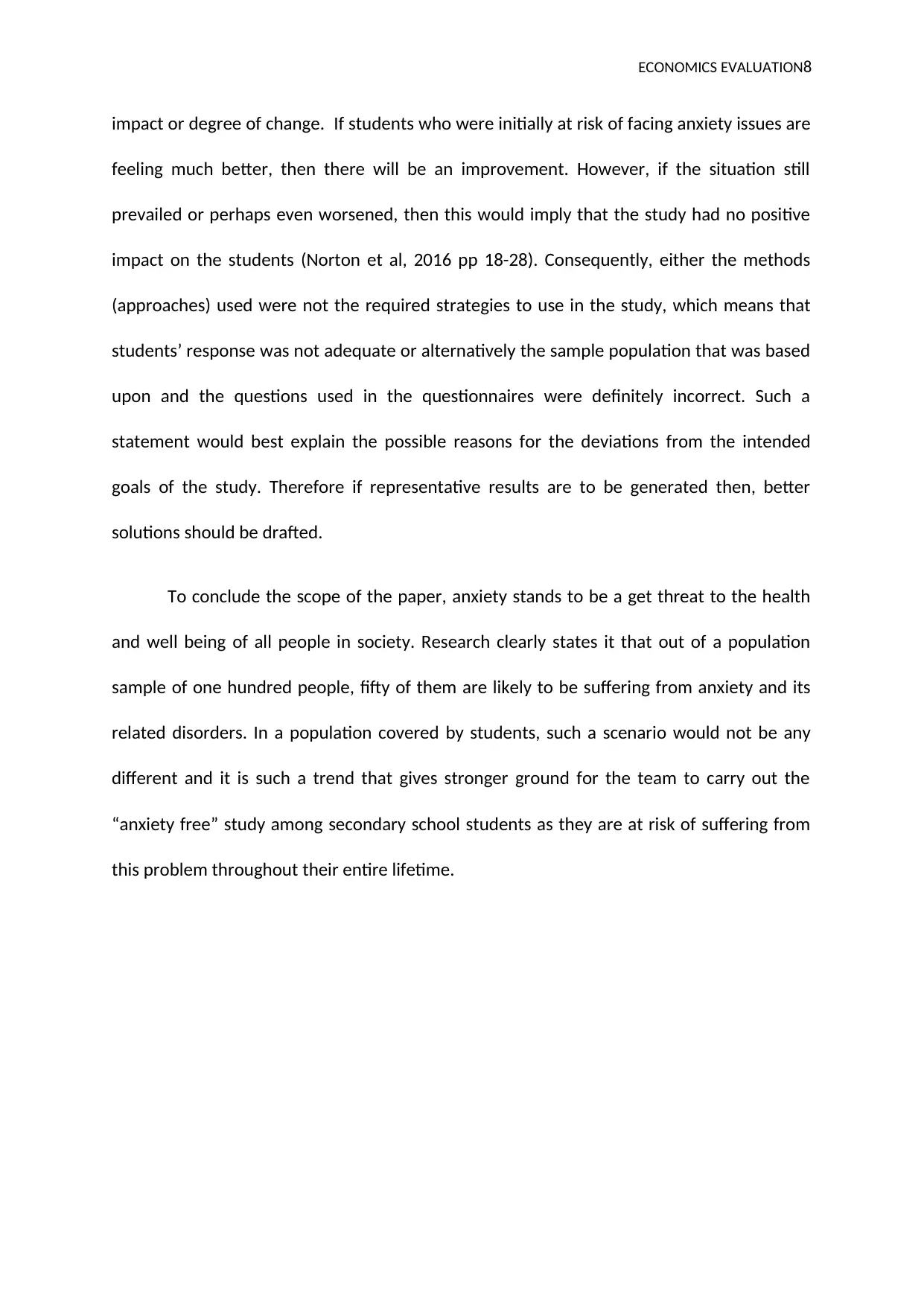
ECONOMICS EVALUATION8
impact or degree of change. If students who were initially at risk of facing anxiety issues are
feeling much better, then there will be an improvement. However, if the situation still
prevailed or perhaps even worsened, then this would imply that the study had no positive
impact on the students (Norton et al, 2016 pp 18-28). Consequently, either the methods
(approaches) used were not the required strategies to use in the study, which means that
students’ response was not adequate or alternatively the sample population that was based
upon and the questions used in the questionnaires were definitely incorrect. Such a
statement would best explain the possible reasons for the deviations from the intended
goals of the study. Therefore if representative results are to be generated then, better
solutions should be drafted.
To conclude the scope of the paper, anxiety stands to be a get threat to the health
and well being of all people in society. Research clearly states it that out of a population
sample of one hundred people, fifty of them are likely to be suffering from anxiety and its
related disorders. In a population covered by students, such a scenario would not be any
different and it is such a trend that gives stronger ground for the team to carry out the
“anxiety free” study among secondary school students as they are at risk of suffering from
this problem throughout their entire lifetime.
impact or degree of change. If students who were initially at risk of facing anxiety issues are
feeling much better, then there will be an improvement. However, if the situation still
prevailed or perhaps even worsened, then this would imply that the study had no positive
impact on the students (Norton et al, 2016 pp 18-28). Consequently, either the methods
(approaches) used were not the required strategies to use in the study, which means that
students’ response was not adequate or alternatively the sample population that was based
upon and the questions used in the questionnaires were definitely incorrect. Such a
statement would best explain the possible reasons for the deviations from the intended
goals of the study. Therefore if representative results are to be generated then, better
solutions should be drafted.
To conclude the scope of the paper, anxiety stands to be a get threat to the health
and well being of all people in society. Research clearly states it that out of a population
sample of one hundred people, fifty of them are likely to be suffering from anxiety and its
related disorders. In a population covered by students, such a scenario would not be any
different and it is such a trend that gives stronger ground for the team to carry out the
“anxiety free” study among secondary school students as they are at risk of suffering from
this problem throughout their entire lifetime.
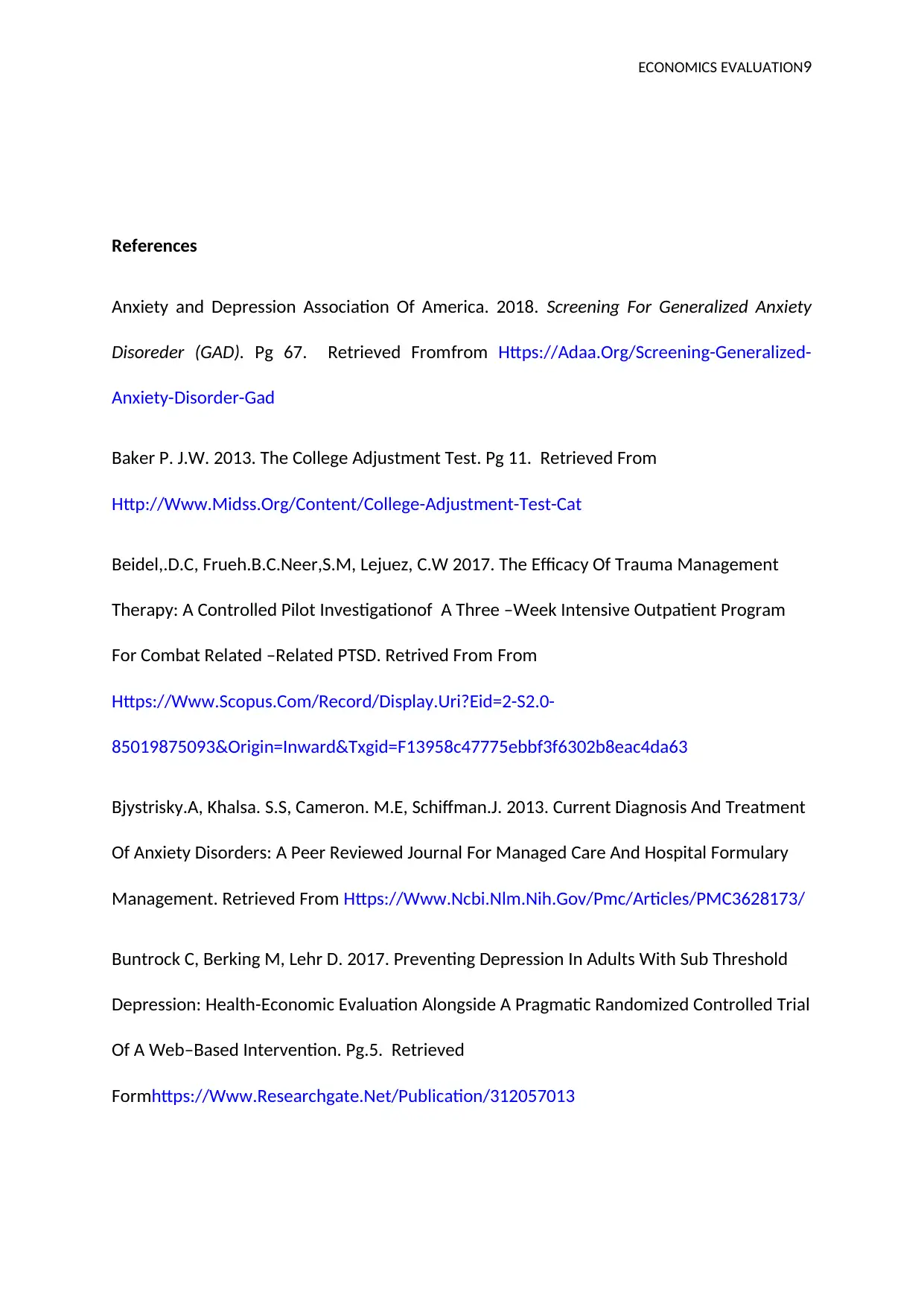
ECONOMICS EVALUATION9
References
Anxiety and Depression Association Of America. 2018. Screening For Generalized Anxiety
Disoreder (GAD). Pg 67. Retrieved Fromfrom Https://Adaa.Org/Screening-Generalized-
Anxiety-Disorder-Gad
Baker P. J.W. 2013. The College Adjustment Test. Pg 11. Retrieved From
Http://Www.Midss.Org/Content/College-Adjustment-Test-Cat
Beidel,.D.C, Frueh.B.C.Neer,S.M, Lejuez, C.W 2017. The Efficacy Of Trauma Management
Therapy: A Controlled Pilot Investigationof A Three –Week Intensive Outpatient Program
For Combat Related –Related PTSD. Retrived From From
Https://Www.Scopus.Com/Record/Display.Uri?Eid=2-S2.0-
85019875093&Origin=Inward&Txgid=F13958c47775ebbf3f6302b8eac4da63
Bjystrisky.A, Khalsa. S.S, Cameron. M.E, Schiffman.J. 2013. Current Diagnosis And Treatment
Of Anxiety Disorders: A Peer Reviewed Journal For Managed Care And Hospital Formulary
Management. Retrieved From Https://Www.Ncbi.Nlm.Nih.Gov/Pmc/Articles/PMC3628173/
Buntrock C, Berking M, Lehr D. 2017. Preventing Depression In Adults With Sub Threshold
Depression: Health-Economic Evaluation Alongside A Pragmatic Randomized Controlled Trial
Of A Web–Based Intervention. Pg.5. Retrieved
Formhttps://Www.Researchgate.Net/Publication/312057013
References
Anxiety and Depression Association Of America. 2018. Screening For Generalized Anxiety
Disoreder (GAD). Pg 67. Retrieved Fromfrom Https://Adaa.Org/Screening-Generalized-
Anxiety-Disorder-Gad
Baker P. J.W. 2013. The College Adjustment Test. Pg 11. Retrieved From
Http://Www.Midss.Org/Content/College-Adjustment-Test-Cat
Beidel,.D.C, Frueh.B.C.Neer,S.M, Lejuez, C.W 2017. The Efficacy Of Trauma Management
Therapy: A Controlled Pilot Investigationof A Three –Week Intensive Outpatient Program
For Combat Related –Related PTSD. Retrived From From
Https://Www.Scopus.Com/Record/Display.Uri?Eid=2-S2.0-
85019875093&Origin=Inward&Txgid=F13958c47775ebbf3f6302b8eac4da63
Bjystrisky.A, Khalsa. S.S, Cameron. M.E, Schiffman.J. 2013. Current Diagnosis And Treatment
Of Anxiety Disorders: A Peer Reviewed Journal For Managed Care And Hospital Formulary
Management. Retrieved From Https://Www.Ncbi.Nlm.Nih.Gov/Pmc/Articles/PMC3628173/
Buntrock C, Berking M, Lehr D. 2017. Preventing Depression In Adults With Sub Threshold
Depression: Health-Economic Evaluation Alongside A Pragmatic Randomized Controlled Trial
Of A Web–Based Intervention. Pg.5. Retrieved
Formhttps://Www.Researchgate.Net/Publication/312057013
⊘ This is a preview!⊘
Do you want full access?
Subscribe today to unlock all pages.

Trusted by 1+ million students worldwide
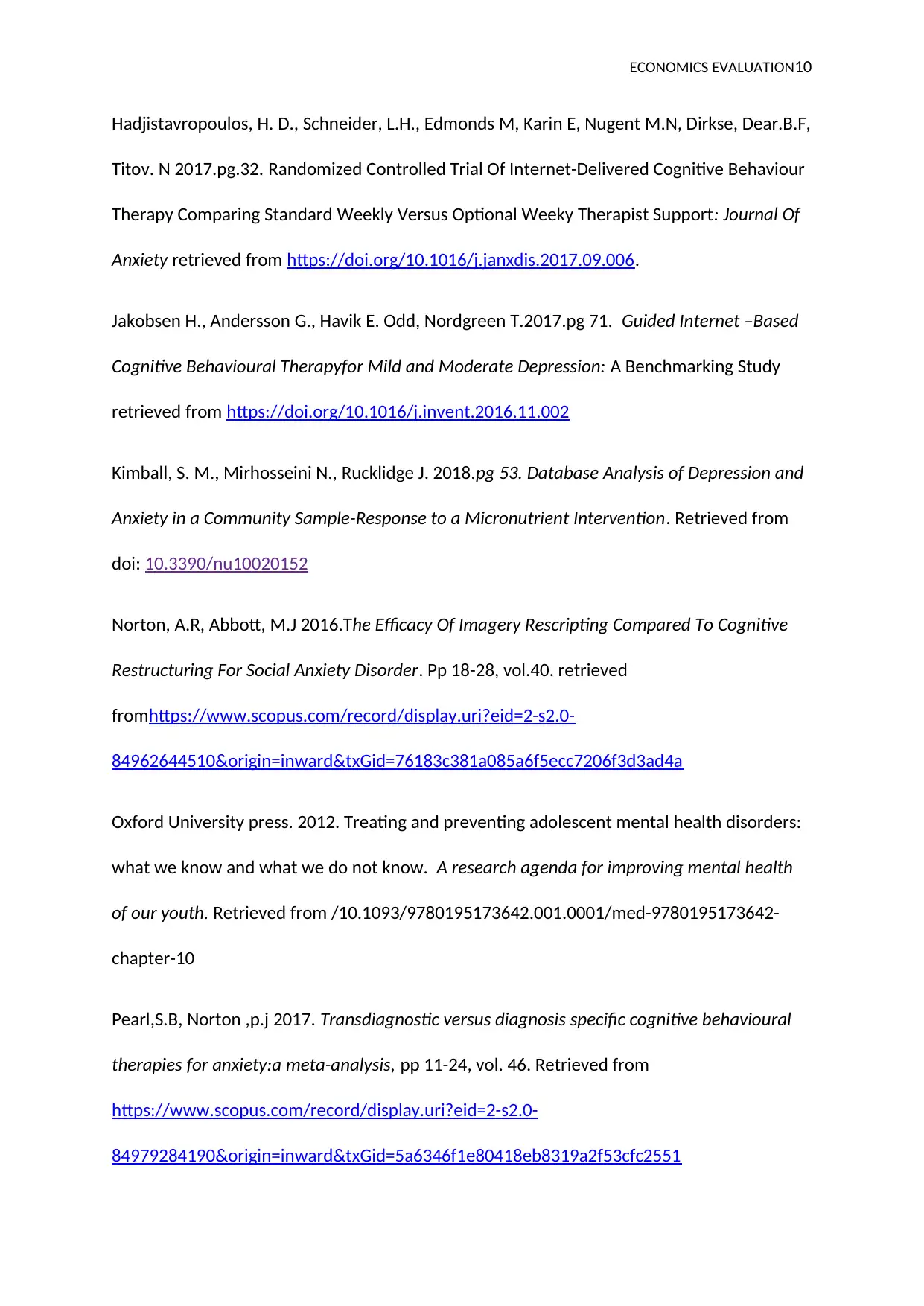
ECONOMICS EVALUATION10
Hadjistavropoulos, H. D., Schneider, L.H., Edmonds M, Karin E, Nugent M.N, Dirkse, Dear.B.F,
Titov. N 2017.pg.32. Randomized Controlled Trial Of Internet-Delivered Cognitive Behaviour
Therapy Comparing Standard Weekly Versus Optional Weeky Therapist Support: Journal Of
Anxiety retrieved from https://doi.org/10.1016/j.janxdis.2017.09.006.
Jakobsen H., Andersson G., Havik E. Odd, Nordgreen T.2017.pg 71. Guided Internet –Based
Cognitive Behavioural Therapyfor Mild and Moderate Depression: A Benchmarking Study
retrieved from https://doi.org/10.1016/j.invent.2016.11.002
Kimball, S. M., Mirhosseini N., Rucklidge J. 2018.pg 53. Database Analysis of Depression and
Anxiety in a Community Sample-Response to a Micronutrient Intervention. Retrieved from
doi: 10.3390/nu10020152
Norton, A.R, Abbott, M.J 2016.The Efficacy Of Imagery Rescripting Compared To Cognitive
Restructuring For Social Anxiety Disorder. Pp 18-28, vol.40. retrieved
fromhttps://www.scopus.com/record/display.uri?eid=2-s2.0-
84962644510&origin=inward&txGid=76183c381a085a6f5ecc7206f3d3ad4a
Oxford University press. 2012. Treating and preventing adolescent mental health disorders:
what we know and what we do not know. A research agenda for improving mental health
of our youth. Retrieved from /10.1093/9780195173642.001.0001/med-9780195173642-
chapter-10
Pearl,S.B, Norton ,p.j 2017. Transdiagnostic versus diagnosis specific cognitive behavioural
therapies for anxiety:a meta-analysis, pp 11-24, vol. 46. Retrieved from
https://www.scopus.com/record/display.uri?eid=2-s2.0-
84979284190&origin=inward&txGid=5a6346f1e80418eb8319a2f53cfc2551
Hadjistavropoulos, H. D., Schneider, L.H., Edmonds M, Karin E, Nugent M.N, Dirkse, Dear.B.F,
Titov. N 2017.pg.32. Randomized Controlled Trial Of Internet-Delivered Cognitive Behaviour
Therapy Comparing Standard Weekly Versus Optional Weeky Therapist Support: Journal Of
Anxiety retrieved from https://doi.org/10.1016/j.janxdis.2017.09.006.
Jakobsen H., Andersson G., Havik E. Odd, Nordgreen T.2017.pg 71. Guided Internet –Based
Cognitive Behavioural Therapyfor Mild and Moderate Depression: A Benchmarking Study
retrieved from https://doi.org/10.1016/j.invent.2016.11.002
Kimball, S. M., Mirhosseini N., Rucklidge J. 2018.pg 53. Database Analysis of Depression and
Anxiety in a Community Sample-Response to a Micronutrient Intervention. Retrieved from
doi: 10.3390/nu10020152
Norton, A.R, Abbott, M.J 2016.The Efficacy Of Imagery Rescripting Compared To Cognitive
Restructuring For Social Anxiety Disorder. Pp 18-28, vol.40. retrieved
fromhttps://www.scopus.com/record/display.uri?eid=2-s2.0-
84962644510&origin=inward&txGid=76183c381a085a6f5ecc7206f3d3ad4a
Oxford University press. 2012. Treating and preventing adolescent mental health disorders:
what we know and what we do not know. A research agenda for improving mental health
of our youth. Retrieved from /10.1093/9780195173642.001.0001/med-9780195173642-
chapter-10
Pearl,S.B, Norton ,p.j 2017. Transdiagnostic versus diagnosis specific cognitive behavioural
therapies for anxiety:a meta-analysis, pp 11-24, vol. 46. Retrieved from
https://www.scopus.com/record/display.uri?eid=2-s2.0-
84979284190&origin=inward&txGid=5a6346f1e80418eb8319a2f53cfc2551
Paraphrase This Document
Need a fresh take? Get an instant paraphrase of this document with our AI Paraphraser
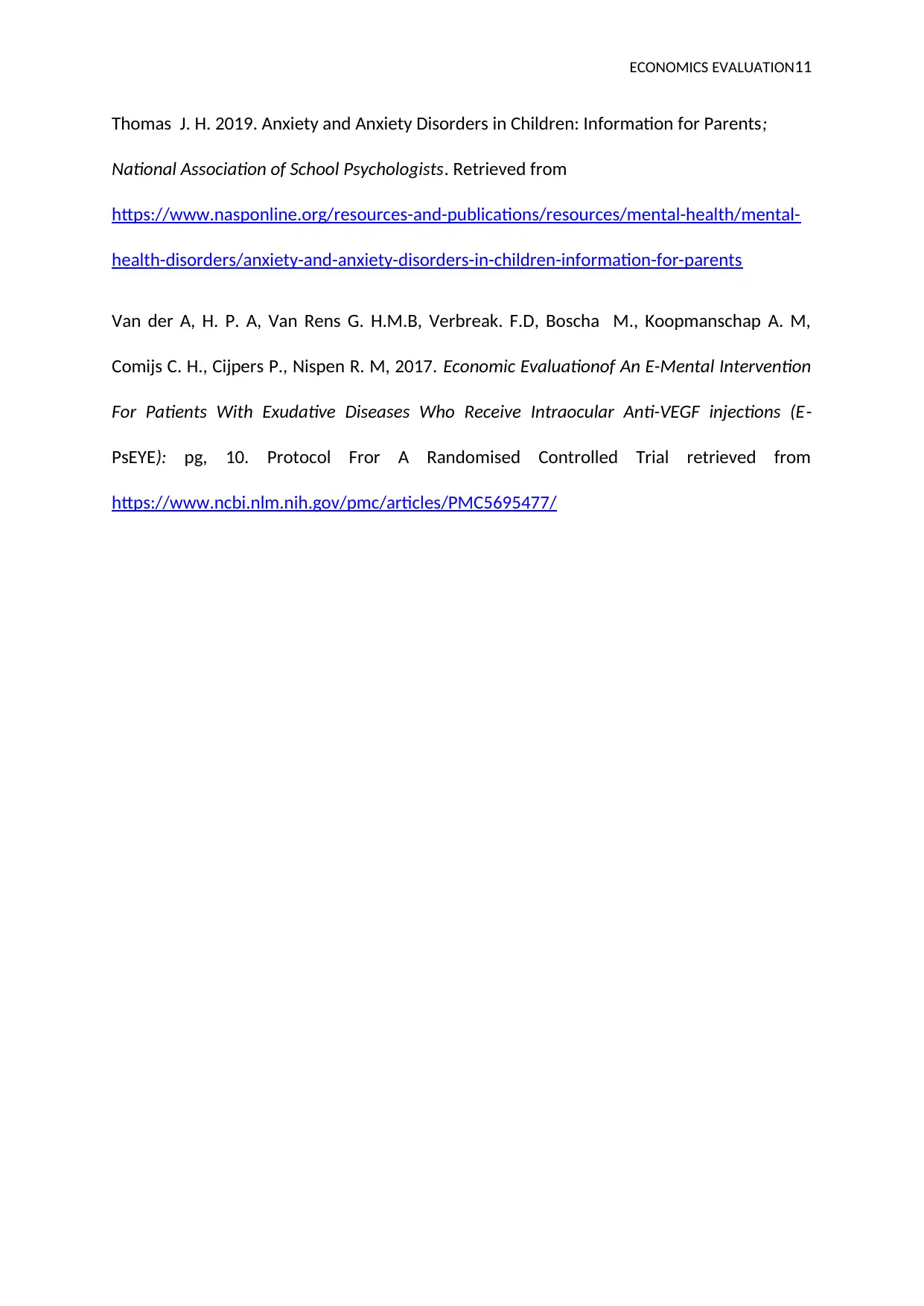
ECONOMICS EVALUATION11
Thomas J. H. 2019. Anxiety and Anxiety Disorders in Children: Information for Parents;
National Association of School Psychologists. Retrieved from
https://www.nasponline.org/resources-and-publications/resources/mental-health/mental-
health-disorders/anxiety-and-anxiety-disorders-in-children-information-for-parents
Van der A, H. P. A, Van Rens G. H.M.B, Verbreak. F.D, Boscha M., Koopmanschap A. M,
Comijs C. H., Cijpers P., Nispen R. M, 2017. Economic Evaluationof An E-Mental Intervention
For Patients With Exudative Diseases Who Receive Intraocular Anti-VEGF injections (E-
PsEYE): pg, 10. Protocol Fror A Randomised Controlled Trial retrieved from
https://www.ncbi.nlm.nih.gov/pmc/articles/PMC5695477/
Thomas J. H. 2019. Anxiety and Anxiety Disorders in Children: Information for Parents;
National Association of School Psychologists. Retrieved from
https://www.nasponline.org/resources-and-publications/resources/mental-health/mental-
health-disorders/anxiety-and-anxiety-disorders-in-children-information-for-parents
Van der A, H. P. A, Van Rens G. H.M.B, Verbreak. F.D, Boscha M., Koopmanschap A. M,
Comijs C. H., Cijpers P., Nispen R. M, 2017. Economic Evaluationof An E-Mental Intervention
For Patients With Exudative Diseases Who Receive Intraocular Anti-VEGF injections (E-
PsEYE): pg, 10. Protocol Fror A Randomised Controlled Trial retrieved from
https://www.ncbi.nlm.nih.gov/pmc/articles/PMC5695477/

ECONOMICS EVALUATION12
⊘ This is a preview!⊘
Do you want full access?
Subscribe today to unlock all pages.

Trusted by 1+ million students worldwide
1 out of 12
Related Documents
Your All-in-One AI-Powered Toolkit for Academic Success.
+13062052269
info@desklib.com
Available 24*7 on WhatsApp / Email
![[object Object]](/_next/static/media/star-bottom.7253800d.svg)
Unlock your academic potential
Copyright © 2020–2025 A2Z Services. All Rights Reserved. Developed and managed by ZUCOL.





